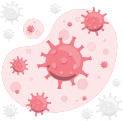A flat head in babies is a common concern for many parents. While this asymmetrical head shape is generally not harmful, it can affect a baby’s physical appearance.
What causes a flat baby head, and how can it be corrected? Read on for more details.
Causes of a Flat Baby Head
Medically, a flat head condition is known as plagiocephaly. This occurs when a baby’s head develops an asymmetrical shape, often appearing flat on one side. In some cases, plagiocephaly can also cause the forehead on the opposite side to look more prominent.
Several factors contribute to a flat head in babies, including:
Congenital Muscular Torticollis
Congenital muscular torticollis is a condition present at birth, where the neck muscles become abnormally tight, limiting head movement. As a result, the baby tends to keep their head tilted to one side, putting excessive pressure on one area of the skull and leading to a flat spot.
Premature Birth
Premature babies have softer skulls compared to full-term infants, making them more prone to developing a flat head. Additionally, premature babies often require extended hospital stays, where they remain in the same position for long periods, contributing to head asymmetry.
Supine Sleeping Position
Placing babies on their backs to sleep is recommended to reduce the risk of sudden infant death syndrome (SIDS). However, if a baby remains in the same sleeping position for extended periods, it can create excessive pressure on the back of the head, leading to a flattened area.
Other Contributing Factors
Excessive use of car seats, bouncers, or strollers, as well as pressure exerted on the baby’s head in the womb, can also contribute to head flattening.
How to Correct a Flat Head in Babies
An asymmetrical head shape in babies can often be corrected with early intervention. Here are some recommended approaches:
- Change sleeping positions regularly – Adjust the baby's head position while they sleep to prevent constant pressure on one side.
- Encourage tummy time – Allow the baby to spend supervised time on their stomach while awake to help strengthen neck muscles and reduce pressure on the back of the head.
- Use a specially designed pillow – An ergonomic baby pillow may help distribute pressure more evenly and prevent further flattening.
- Limit time in car seats and strollers – Reduce prolonged lying down in car seats, bouncers, or strollers to minimize continuous pressure on one area of the head.
If the flat head is caused by torticollis or does not improve with these methods, consulting a doctor is recommended. A healthcare provider may suggest physical therapy to loosen tight neck muscles or, in severe cases, the use of a corrective helmet to help reshape the skull.
Have further questions about flat heads in babies? You can consult a doctor using the Ai Care application, available for download on the App Store or Play Store.
Looking for more information about pregnancy, breastfeeding, women's and children's health? Click here!
- dr Nadia Opmalina
Cleveland Clinic (2023). Plagiocephaly (Flat Head Syndrome). Available from: https://my.clevelandclinic.org/health/diseases/10691-plagiocephaly-flat-head-syndrome
Kids Health (2023). Flat Head Syndrome (Positional Plagiocephaly). Available from: https://kidshealth.org/en/parents/positional-plagiocephaly.html
John Hopkins Medicine. Deformational Plagiocephaly. Available from: https://www.hopkinsmedicine.org/health/conditions-and-diseases/deformational-plagiocephaly
CHOP. Congenital Muscular Torticollis. Available from: https://www.chop.edu/conditions-diseases/congenital-muscular-torticollis












